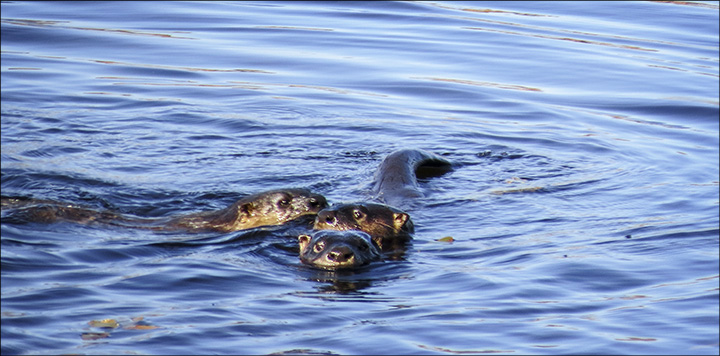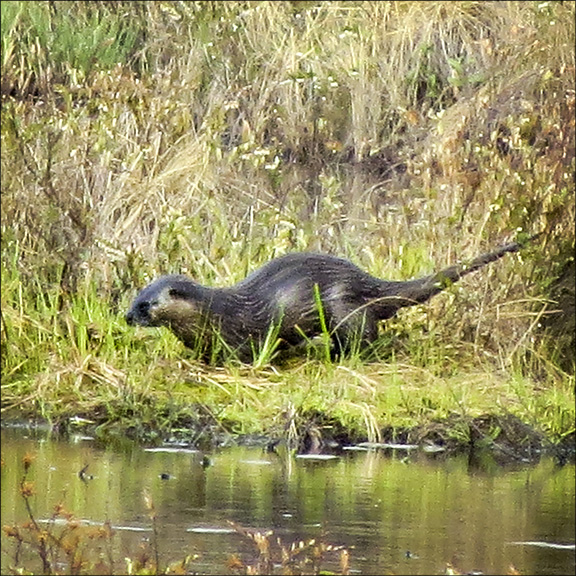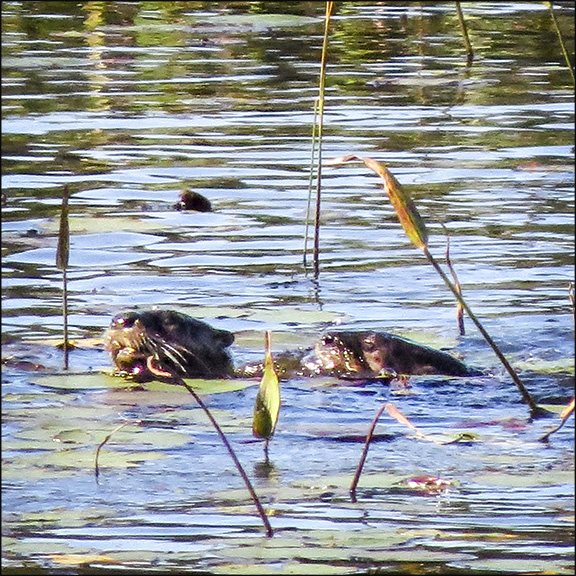Adirondack Wildlife:
North American River Otter
 Adirondack Wildlife: North American River Otters playing on Heron Marsh at the Paul Smiths VIC (6 October 2014)
Adirondack Wildlife: North American River Otters playing on Heron Marsh at the Paul Smiths VIC (6 October 2014)
The North American River Otter is one of the most entertaining of the many creatures who make the VIC's wetlands their home. North American River Otters (Lontra canadensis) are members of the weasel family who grow three to four feet long and weigh 10 to 30 pounds. The head is broad and flat, with short, rounded ears. River otters have glossy, brown guard hairs over a short, oily underfur. River otters are a semi-aquatic mammal; they are swift and agile swimmers who make use of a long, muscular tail and webbed feet. They can remain submerged for several minutes at a time. River otters usually do not survive more than ten years in the wild, although they may live up to twenty years in captivity.

River Otters at the VIC: At the VIC, North American River Otters are frequently seen on Heron Marsh. The best places for viewing them are from the overlooks on the Heron Marsh Trail (particularly on the raised tower), on the floating bridge on the Woods and Waters Trail, and at Shingle Mill Falls on the Loggers Loop Trail. River otters have also been seen from the viewing platforms on the Barnum Brook Trail. Look for glimpses of their dark, shiny brown heads, moving quickly through the water on Heron Marsh or flashing in and out of the vegetation on the edge of the marsh. You might also spot an otter by looking for its wake in the water. The best time to catch sight of an otter at the VIC is early morning or late afternoon.
History of the River Otter: At one time, river otters could be found in all watershed in New York State, but unregulated trapping, habitat destruction, and water pollution reduced their numbers. Legal protection for these animals was first established in 1936, leading to a resurgence in otter numbers. Until the early 1990s, however, few river otters could be found in the western half of the state. In response, the New York River Otter Project was established in the late 1990s; it involved trapping river otters in eastern New York and releasing them in the central and western part of the state.
River Otter Habitat: River otters live in rivers, lakes, ponds, small streams, marshes, and other inland wetlands. River otters are often found in the same freshwater wetlands as beaver. Dens are usually found near water and often have underwater entrances. Otters generally do not excavate their own dwellings, but use the burrows of beaver or other mammals for their den sites. At the VIC, both river otters and beaver live on Heron Marsh.

Diet: River otters are carnivores and will consume almost anything they can catch. They are primarily visual predators. However, they also have motion-sensitive whiskers which enable them to forage in murky waters and find their prey by sensing vibrations with their whiskers. Fish comprise the majority of their diet, but they will also take crustaceans and other aquatic invertebrates. At the VIC, the river otters feed on fresh-water mussels and clams in Heron Marsh, as well as fish.
Breeding: River otter young are born in April or May. Adults provide them food for up to 10 months. Males or a non-breeding female may remain with the family group temporarily. Juvenile otters usually remain with the female until she bears her next litter the following spring, dispersing when they are 12 to 13 months old. The main social unit is the family -- generally one adult female and her young. The three otters frequently seen at the VIC during the summer and fall of 2015 probably comprised such a family group.
River Otter Behavior: Otters are usually nocturnal, with peak activity occurring around midnight and just before dawn. There is no hibernation period. They are active year-round and may be more active during the winter, when they reportedly become more active during the daytime hours.
- Otter Play Time: Highly energetic, river otters spend much of their time playing. They may be observed touching, shoving, tossing, and manipulating prey, stones or other objects, or tobogganing down mud or snow slides. At the VIC, young otters may be seen playing in Heron Marsh, especially during the fall. During the winter, look for skid marks in the snow, especially at the marsh outlet at Shingle Mill Falls (accessible by the Heron Marsh Trail and the Loggers Loop Trail), where otters have tobogganed over the falls. These tracks in the snow, formed when an otter moves along the ground or down a slope on its belly, are evidence of otter play.
- Otter Vocalization: Otters are quite vocal, using chirping and humming sounds as contact calls. On the overlooks and trails near Heron Marsh, listen for a series of squeaks and chirps.
References
William K. Chapman. Mammals of the Adirondacks. A Field Guide (North Country Books, 1991), pp. 13, 104, 106, 146, Plate 17.
James M. Ryan. Adirondack Wildlife. A Field Guide (University of New Hamshire Press, 2008), pp. 205-206.
New York State Department of Environmental Conservation. River Otter. Retrieved 6 October 2014.
New York State Department of Environmental Conservation. Watchable Wildlife: River Otter. Retrieved 6 October 2014.
New York State Department of Environmental Conservation. River Otters (video). Retrieved 6 October 2014.
State University of New York. College of Environmental Science and Forestry. River Otter. Retrieved 6 October 2014.
Curt Stager. Field Notes from the Northern Forest (Syracuse University Press, 1998), pp. 166-167.
IUCN Red List of Threatened Species. Lontra canadensis. Retrieved 6 October 2014.
Environmental Protection Agency. Species Profile: River Otter. Retrieved 6 October 2014.
